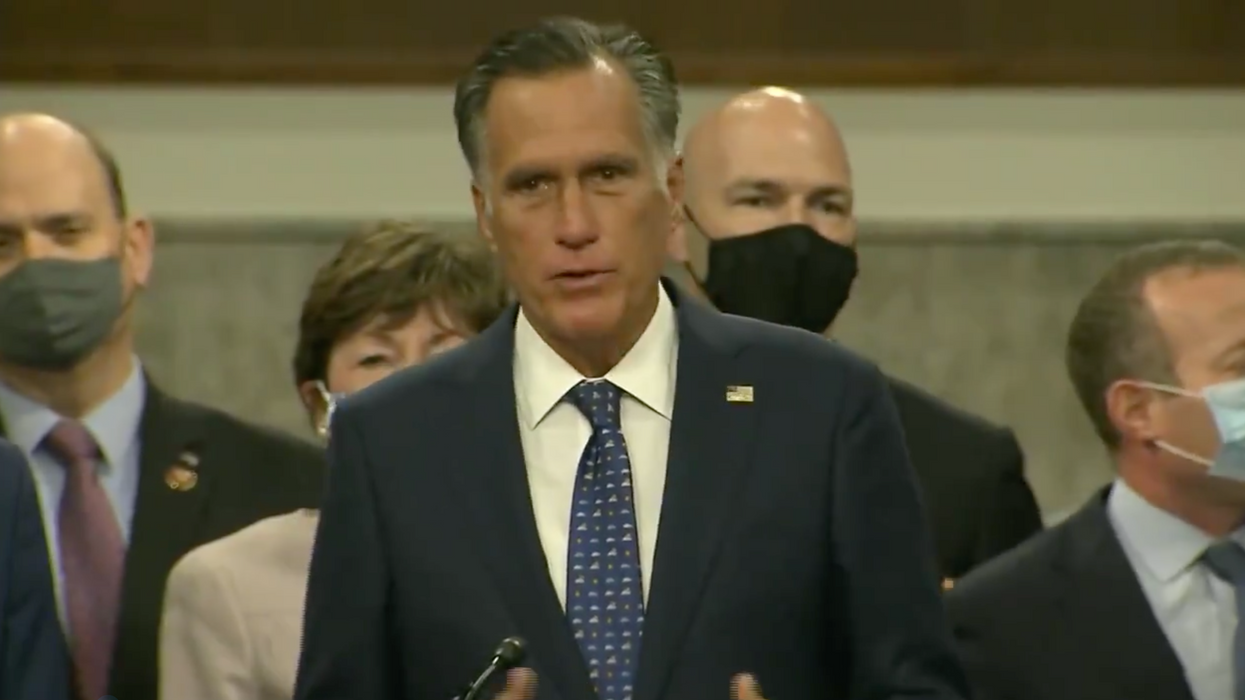Why Liberals -- And Conservatives -- Should Back Romney’s Child Bill
It may be coincidence that the best policy idea to come out of the 117th Congress was offered by the one guy who has demonstrated the integrity to brave harassment and death threats to do what's right vis a vis former President Donald Trump. Mitt Romney has an excellent plan to reduce child poverty.
This country has a serious child problem. Our birth rates are low and heading lower, which endangers the prospects for Social Security and Medicare for our large elderly population. Also, old countries tend to lack dynamism, which has always been an American specialty. Some couples are happy with their small family sizes, but most Americans want more children (2.7) than they are likely to have (1.8).
About 20% of American kids live in poverty compared with 13% among all OECD countries. Part of the reason our kids are struggling is due to changes in family structure. Though the marriage norm has declined nearly everywhere, the U.S. holds the dubious distinction of leading the developed world in unstable adult relationships. Child Trends reports that the 2017 poverty rate for children in married couple families was 8.4%. For kids in single mother homes, the poverty rate was 40.7%.
Clearly, a return to the two-parent norm (updated to include same-sex marriages) would be ideal. But that is a complicated cultural matter that governments have limited capacity to affect — except, as the Romney Family Plan envisions, we can at least stop doing the things that penalize marriage. Our system of getting aid to children is convoluted. Because we Americans love to disguise spending as "tax policy," we offer a "child care tax credit" along with a child allowance included in the Earned Income Tax Credit. The poorest families receive TANF. The way the EITC is structured, an analysis for the Niskanen Center demonstrates, can cost couples between 15% and 25% of income if they marry. Also, the child care tax credit, which the Biden administration's proposal would expand, serves as a pass-through to increase prices for providers without helping the average family choose the kind of relative-provided or local child care arrangements that most families prefer. It also preferences paid day care over parental care.
The Romney proposal would sweep away TANF, the tax credits and the rest in favor of a simplified and more generous child allowance of $4,200 per year for children up to age 6, and $3,000 per year for children ages 6-17.
Conservatives worry about the disincentive to work inherent in traditional welfare programs, which reasonable. But part of the old "poverty trap" was not the child allowance per se but the implicit high marginal tax on earnings as parents reentered the workforce. Niskanen points to Canada's experience with a direct child allowance, finding that labor force participation actually increased after their child allowance was increased in 2016.
Another benefit of Romney's approach is that it respects the wishes of parents. There's a weakness on the left for the idea of clean, bright day care centers staffed by Ph.D.s. But a quick glance at the local public school should be enough to raise doubts about the supply of "high quality" care. In fact, most day care arrangements are far from ideal. Here again, Canada's recent experience is instructive. Quebec instituted a $5 per day universal day care in 1997. The number of families placing preschoolers in care jumped by 33%. But a study published in 2015 by the National Bureau of Economic Research found some disturbing results. Compared with kids from other provinces, Quebec's kids were less healthy and less satisfied with life. Most strikingly, Quebec experienced a spike in crime among the teenagers who had been in day care as children.
The direct child allowance gives parents the flexibility to make decisions about care. Some will use professional daycare centers, others will opt for help from relatives and friends, and still others will use the extra income to permit one parent to stay at home while the kids are little.
Romney's proposal is also pro-life. Family incomes tend to decline in the second half of pregnancy, so Romney's child allowance would begin four months before a child's birth. According to the Alan Guttmacher Institute, some 28% of abortion patients cite financial worries as one of the reasons for terminating a pregnancy.
Poverty isn't good for anyone, but arguably child poverty is more damaging to society than any other kind. An Institute for Social and Economic research paper found that for every 1% increase in unemployment during the Great Recession, there was a 25% increase in child neglect. This effect was muted in states with more generous safety nets. Niskanen estimates that Romney's proposal would reduce child poverty by one-third and cut deep poverty in half. It would accomplish this without adding to the deficit since the proposal contains offsets (specifically, eliminating the state and local tax exemption that mostly benefits wealthy individuals in high tax states).
This is what policymaking is supposed to look like. With any luck, Romney's proposal will at least spark debate on a critical challenge for our country. A few years ago, that would have been normal. In 2021, it would be nirvana.
Mona Charen is policy editor of The Bulwark and host of the "Beg to Differ" podcast. Her most recent book is "Sex Matters: How Modern Feminism Lost Touch with Science, Love, and Common Sense." To read features by other Creators Syndicate writers and cartoonists, visit the Creators Syndicate webpage at www.creators.com.









